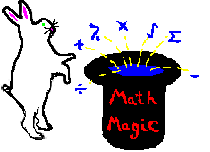

[ Home ] [ FOIL Method ] [ Double & Half Method ] [ Squaring Numbers ] [ Squaring Num End In 5 ] [ Squaring Num End In 6 ] [ Squaring Num End In 7 ] [ Squaring Num End In 8 ] [ Squaring Num End in 9 ] [ Squaring Nums 40-49 ] [ Squaring Nums 50-59 ] [ Squaring Nums 90-99 ] [ Difference of 2 Squares ] [ Mult Nums End in 5 ] [ Mult Nums One's Add 10 ] [ Mult Nums One's Add 5 ] [ Mult Nums Same Ten's Digits ] [ Mult Nums Tens Add 10 ] [ Mult Nums Less 100 ] [ Mult Nums More 100 ] [ Mult Nums More 100 Less 100 ] [ AB + BC ] [ AA + 2AA ] [ AA + 3AA ] [ AA + 7AA ] [ AA + 10AA ] [ Mult Nums Less 1000 ] [ Mult Nums More 1000 ] [ Add 2 Squares ] [ Product of 4 Nums ] [ Adding Consecutive Squares ] [ Squaring: 101a ] [ Adding Squares #2 ]
(*View/Download
.pdf file)
Product of 4 Consecutive Integers Plus 1:
A. From algebra we know:
n x (n+1) x (n+2) x (n+3) + 1 = [n x
(n+3) + 1]2
B.
Using numbers instead of variables we get:
1. Multiply
the first and last of the consecutive numbers together.
2. Add 1 to
step 1.
3. Square
the result of step 2.
Ex [1] 5
x 6 x 7 x 8 + 1=_________.
a) 5 x 8 =
40.
b) (40 +
1)2 = 1681.
c) The
answer is 1681.
Ex [2] 9
x 10 x 11 x 12 + 1 =_________.
a) 9 x 12
= 108.
b) (108 +
1)2 = 11881. See Multiplying
Numbers Greater Than 100.
c) The
answer is 11881.
Back to top

